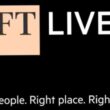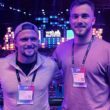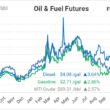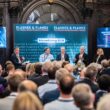Ten years ago today (June 22), former British magazine publisher Chris Anderson – who had made and lost a £300mn fortune – took a decision that would change the world forever. Having become curator of the TED conference, he tentatively made the first six TED Talks available free online. To his astonishment, the 18-minute podcasts quickly went viral. Within three months, they had reached more than one million views: “At that point, we thought ‘OK, I guess we’re no longer just a conference’…” TED became “an odd, quirky media company in the service of ideas rather than news or gossip”. Today, TED Talks are very much better known than the elite Silicon Valley conference which spawned them – and have so far attracted almost 4bn views globally, with more than 3m views each day, across a variety of platforms, from their own site to Netflix and iTunes. TED is a global movement.
The conference had originally been launched in 1984 by architect and graphic designer Richard Wurman, to explore the growing convergence of ideas across “Technology, Entertainment and Design”. The first event included demonstrations of a new device called a compact disc, 3D graphics from Lucasfilm, and a talk by mathematician Benoit Mandelbrot on mapping coastlines using his theory of fractal geometry. But it lost money, and Wurman and his partner Harry Marks waited six years before they dared to try again.
By the time the conference resumed in 1990, everything had changed: it was a huge success and TED became an annual event in Monterey, California. Presenters including scientists, philosophers, musicians, business and religious leaders, and philanthropists attracted a growing worldwide audience. Chris Anderson discovered TED in 1998. He attended what was still an invitation-only event for the nobility of Silicon Valley. He was enthralled to find himself in conversation with dreamers and optimists like himself, talking about the relationship between human evolution and technology, and the future of mankind. “I felt I’d come home,” he says.
Three years later, he acquired TED and started a revolution. Under his direction, it has evolved from a small gathering of thinkers into a global phenomenon accessible by people everywhere. More than 2,000 talks are available on the TED website. There’s no advertising, no sponsorship and the TED Talks podcasts are free to users everywhere.
Over the years, notable speakers have included: Bill Gates, Edward Snowden (who addressed a TED conference from Moscow in 2014), Al Gore, Sheryl Sandberg, Thandie Newton, Annie Lennox, Richard Dawkins, Billy Graham, Monica Lewinsky, Larry Page, Glenn Greenwald, David Cameron, Jeff Bezos, Richard Branson, Gordon Brown, Thomas Piketty, Jimmy Wales, Bill Clinton, and Bono. And there have been hundreds of other ‘thought leaders’ you may not have heard of but would – I bet – still be stimulated by what they have to say.
The cornucopia of talks includes: “How to fix a broken education system without any more money”; “How young blood might reverse ageing”; “Why we have too few women leaders”; “The surprising science of happiness”; A headset that reads your brainwaves”; and the most popular of all (39mn views, no less) “Do schools kill creativity?”. That is a taste of the magic of TED.
The annual conference, held now in a custom-built space at the Vancouver Convention Centre, is a five-day event. Tickets range from $8,500 to $125,000 for ‘TED patrons’ (paying for a five-year membership). This is a non-profit organisation, so revenue goes to fund the web site, production facilities and spin-offs including TED-Ed (video lessons aimed for teachers), a TED fellowship, the TED Radio Hour, and a TED prize.
Anderson summarises the business model of his brilliant global charity: “We have three main sources of revenue: conference fees, sponsorships, and donations. Our main conference in Vancouver is really expensive – $8,500 or more, unless you’re invited as a speaker, fellow or special guest. On the other hand, these fees help fund our web operation that offers all our best content for free. They also fund our ability to offer free TEDx licenses that allow anyone in the world to apply to run a local TEDx event (The ‘x’ stands for ‘self-organised’). Companies like Google, IBM, Intel, Delta and UPS make a huge contribution by sponsoring our website with relatively unobtrusive ads (no pre-roll). And generous donors are the final part of the jigsaw. Overall, it now costs a little over $50m annually to fund TED’s operation. It’s owned by a non-profit foundation and any surplus from the conference is recycled to our other programs.”
The most significant spin-off has been TEDx. On any given day, there are some up to 10 TEDx “franchised” events being held around the world, hosting talks on a very wide range of subjects and promoting “ideas worth spreading”. TED employs more than 150 full-time staff, but Anderson says “the secret sauce” is an army of 40-50,000 volunteers around the world, staging TEDx events and providing translations of talks into some 100 languages.
Anderson believes that – as big as TED has already become – it will only get bigger. “If you don’t completely discount the voices of Silicon Valley, in five or 10 years’ time, there will be pretty much ubiquitous low-cost broadband internet connection around the world. And, in pretty much every village, on the planet there will be someone with a smartphone device, connecting to any human being that is on the internet..”
The former magazine publisher makes the point that online video is becoming as important a revolution as the printing press once was: “The printing press allowed writers to scale their ideas to the world; online video now allows that for a different form of communication. It’s a more powerful form of communication because there’s a whole lot more going on as opposed to just a stream of words: it’s a richer form of communication. You can get inside someone’s head more deeply with the right talk, and the distribution is instant — you don’t have to wait to ship the books. Of course, like early print when a lot of early novels were hardly worth reading, online video is largely used for nonsense. But that doesn’t mean it’s not really powerful.”
Listening to the slightly shy, nerdy Anderson, it is easy to believe he was born to guide this amazing organisation on its way to becoming a uniquely influential global movement. He was actually born in a remote village in Pakistan. His early years were spent in India, Pakistan and Afghanistan where his father worked as a missionary eye surgeon. “I think of TED as fundamentally a global organisation. Ideas know no borders, as they say, and that ‘global soul’ identity definitely came from my childhood.”
He attended boarding school in England. He graduated in philosophy from Oxford University, before turning to journalism where he became passionate about the emerging 1980s craze for computer games and technology. Within a few years, he had launched a first magazine “Amstrad Action” from his kitchen table. By 1985, he had founded Future Publishing with a £15,000 bank loan. For the next seven years, the fledgling British company doubled its turnover, profit, and number of employees every single year. Anderson was a British media star.
These were boom times for magazines and for computer games. And the Future boss neatly made his magazines interactive in pre-internet days with cover-mounted CDs and disks to help readers develop their skills, try-out computer games and play music they had read about. Future described itself as a publisher for “readers with a passion” and his journalists shared the passion.
In 1993, less than 10 years after Future’s launch, media group Pearson Plc bought the company for £52.5mn. Anderson banked his winnings and moved to San Francisco where he created Imagine Media (a US version of Future) and a computer and console games website called the Imagine Games Network (IGN).
A few years on, Pearson re-sold Future Publishing to private equity firm APAX – and Chris Anderson again became chairman. The US and UK companies were brought together and floated excitedly on the London Stock Exchange in June 1999, just as media stocks were limbering up for the first dotcom boom. The IPO valued the renamed Future Network Plc at £199mn and early trading boosted it by 25%. But that was just the start.
The quietly-spoken Anderson was an unlikely media tycoon but demonstrated a sure touch by launching Business 2.0, a magazine for the ‘new economy’ whose title had been suggested by Amazon founder Jeff Bezos in conversation at TED in 1999. It became – briefly – one of the fastest growing magazines in the US, notching up 2,000 pages of advertising in its first year. Future was on fire and was worth £1bn within 12 months of its IPO.
Investors were momentarily euphoric about Future, which peaked at more than 100 tech-driven magazines in six countries selling 5m copies every month, with some 2,000 employees. Turnover hit £250mn as the Playstation generation made Chris Anderson and his company rich. But it was all too good to be true. At the height of the boom, his private equity partner escaped with its ramped-up winnings – and left him to face the bust.
Along, with hundreds of ‘new economy’ businesses, the company suddenly faced demands for short-term profits instead of promised long-term growth. The share price collapsed, along with magazine sales, investor confidence, and revenues. Only debt was rising. The market valuation now struggled to reach £25mn.
Anderson was shattered by the collapse. His 24% shareholding, which had briefly been worth £300mn, fell to £6mn. But there was worse. Future was forced to scale-back its magazines and workforce by 40%, in order to survive. It was a bloody 2001 as the founder rued the day he had befriended private equity and the stock market.
The stumbling company was effectively rescued by AOL Time Warner, which paid a life-saving $68mn for the suddenly-lossmaking US edition of Business 2.0. It was, literally, just in time for Future – and for the shooting star of a magazine which, in the event, didn’t survive long at its new owner.
Anderson left his company in 2001, armed with IGN (later sold to News Corp), and the TED conference which his Board colleagues were relieved to offload for £4mn – less than half of what they had paid for it. They could not have imagined what Anderson would achieve next.
Now, TED is conquering the world, the once-soaring magazine is no more, and Anderson is clear about the lessons of failure: “Business 2.0 magazine succeeded and failed because it tracked the excitement around the internet very well. So, for a brief moment of time in 1999, it was an idea whose time had come. Then it crashed and burned with the NASDAQ. At the time it failed, my journey as an entrepreneur had very largely been up and to the right—one success after another. So it’s easy to drink your own Kool-Aid and get over-confident. In most success stories, there’s a huge element of luck. Never forget that, and know that success may not last forever.”
Meanwhile, after three further share price meltdowns and three lost chief executives in 15 years, his former company (now called Future Plc) has a UK stock market value of less than £30mn, which is about 80% down in the past 10 years, never mind the heady days of 2000. Anderson is visibly shaken, even now, by talk of the 15 years of trauma suffered by his former colleagues.
Perhaps, he will be remembering today that it is 30 years since the fledgling magazine publisher moved into its first “proper” offices, a converted house in the city of Bath in England’s south-west. But it is also the 10th anniversary of his “lifesaving” sale of IGN to News Corp for $650mn. That deal was a less well-known component of Rupert Murdoch’s early digital disasters: the subsequent IGN sale to Ziff Davis for less than £100m made none of the headlines devoted to the $545m Murdoch had lost in six years as owner of MySpace.
This year has yet another anniversary for the TED curator: It is 20 years since he established the non-profit Sapling Foundation, with the lofty aim of tackling “global issues through media, entrepreneurship and the development of ideas”. It was through Sapling that he acquired TED in 2001.
As Chris Anderson contemplates an amazing future, he is reminded daily of his former corporate life: TED’s New York office nestles in the local headquarters of Pearson Plc, the UK-based, global company which delivered his first fortune 24 years ago. Now, he’s the giant.





Dear Collin,
Celebrate! TED’s first 10 years of global influence!!
I found it an extraordinary article. Many happy returns to Chris Anderson, the Curator of TED on the 10th Anniversary!
Many thanks for sharing the story with us all. I have shared it via Twitter.
With warmest regards,
Culturally yours,
Maitreyee,
Surtarang Broadcast, UK